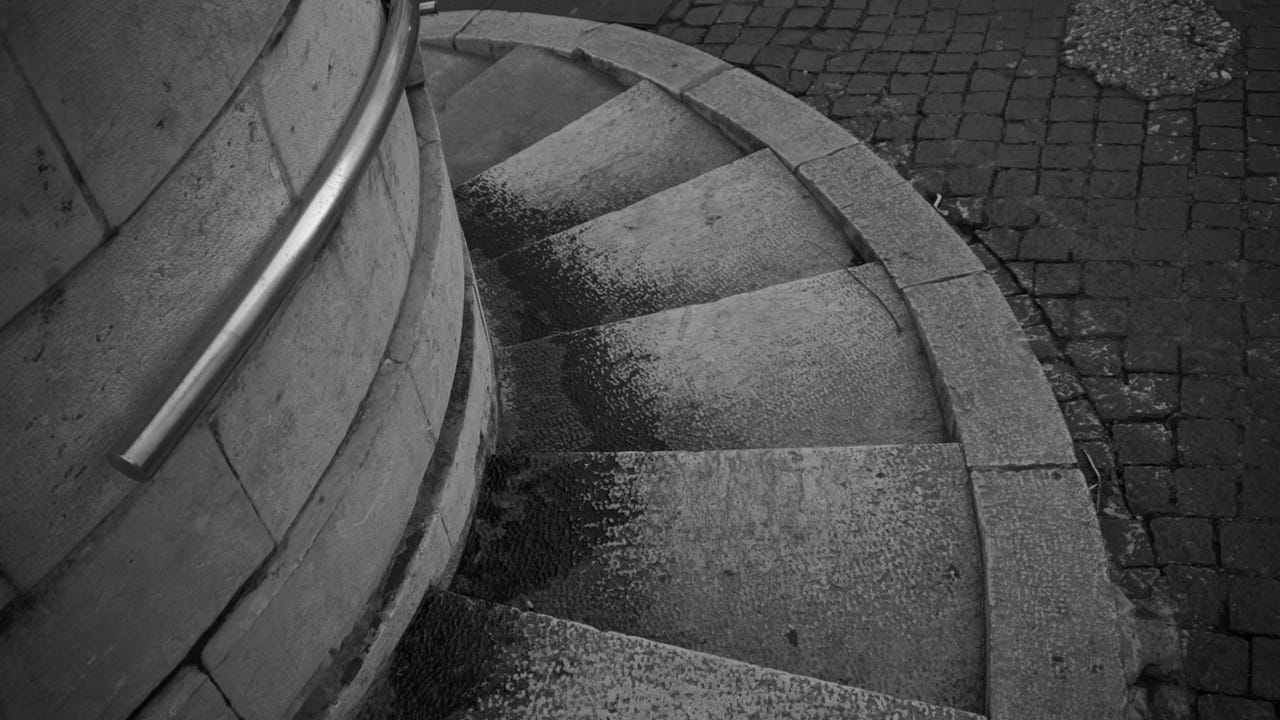Underneath any story with character and conflict and emotion and all the usual elements that you find in a halfway decent narrative, there is, for me, a shape—there’s a geometry, a dimensionality, a visible manifestation of the words, and it always emerges as a clear black line in my mind, one that’s drawn instantaneously whenever I read. This isn’t a decision. It isn’t purposeful. It comes about naturally, as a consequence of how I perceive the topology of the storyline, in its swooping curves, hard turns, and abrupt stops, with each new development extending the line just a bit farther. Some stories are straight, some have little curly cues, some are circular. Designating stories with shapes isn’t exactly a revelation, however, as stories have been studied and outlined and diagramed since, at the very least, Aristotle prescribed a three-act structure for drama, though it’s reasonable to conclude that thoughts about how structure affects story occurred around countless campfires long before that time. What feels different to me is the potency of the black line in my mind, in how it appears without warning and without choice, chiseled from the words as a sculpture is chiseled from marble, and always resulting in a unique shape.
In most writing courses drama is already outlined by a picture, with the general structure typically resembling a mountain: there’s an introduction, a rising action provides the upward slope, the summit is the peak of both story and mountain, and the descent closes the book. Picture an inverted parabola and adjust the symmetry to alter the complications of your tale—push the opening a little faster, pull the ending a little tighter. Some mountains are more jagged than other mountains, full of detours and unmarked trails and falling rocks, just as real stories, thankfully, don’t resemble grid-like parabolas. And if you quickly change the subject before spending too much time pondering this structure, it looks perfectly fine and seems just about right, though if you do happen to examine the shape of this hypothetical mountain and compare that to the structure of most stories, you’ll start asking unfortunate questions.
Thinking about stories in a proportional structure is probably the first mistake—neither good stories nor any aspect of life fit a proportional structure. The black line that bubbles upward in my mind when I read a story doesn’t rise, reach a peak, and then gently fall, with the precision of a mathematical formula. A joke can build and build and build, then end abruptly, right at the punchline; an intense thriller can start with conflict and work backward, offering the resolution before the reader understands the problem; even a climb up a literal mountain has a different valence and time requirement than a descent down that same mountain. The timeworn saying came down from the mountain implies a change, a transformation, with the person who returns different from the person who ventured out, so that any story outline that places the ending at the same level as the beginning is, at best, misleading.
This symmetry is also mirrored in the standard high school essay that’s unfortunately taught in nearly all American schools—the term paper that contains an introduction, a body, and a conclusion, with most students eventually figuring out what an introduction requires, getting a hazy idea of what’s required for the body of a paper, and having absolutely no clue how to write a conclusion. What typically results is a circular structure, very much like the recommended fictional structure, with the introduction foreshadowing the conclusion in a way that’s more tedious and contrived than what I would call organized. To read this formulaic structure is to ingest a toxic dose of sleeping pills, but, if you manage to remain conscious, the black line in your mind might resemble a circle, and you’ll begin to wonder about the passage of time, about how you’ve grown older while you read, about how the universe is stuck with entropy, and about how you are, somehow, back where you started with that introduction, having gone absolutely nowhere.
And it is not incidental that this structure mirrors what many people assume to be the ideal rubric for fiction. Introduce the narrative, delve into your topic, and then return to your original point—with the black line coming to a crisp and rather banal circle. Here is the formula that you’ll be told to follow if you’re giving a short speech, writing a term paper, or laboring with a novel, regardless of the obvious differences of those mediums, and despite the obvious fact that every good speech, paper, and novel ignores those rules. Perhaps the main benefit of this rubric is that it’s teachable—and, more cynically, easy to judge, too, which means that you know when someone is off the mark. But in a world where learning how to write well is pretty much under regular threat, this circular technique probably isn’t the best sales pitch, as it doesn’t accentuate what writing does best, and it almost certainly puts both writer and reader to sleep for understandable reasons—it is static, trite, uninteresting, a purposeless exercise, rather than a trajectory toward discovery.
Tracing the word essay back to its French root brings you to trial or attempt–with the emphasis on testing or, perhaps, weighing. Of course etymology is best for hints and undertones rather than definitive, contemporary meanings, but there’s still something to gain by considering this origin. In thinking of an essay as an attempt you have the implication that an essay is where you experiment and prod and gently move forward without clear guidance but with a desire for meaning—it is to discover what you think at the point of your pen rather than an account of what you already think.
In my mind there’s little to distinguish fiction and non-fiction on this subject: if the writer is surprised and excited by what they discover on the page—as states an old trope about fiction writing—than it is likely that the reader will experience the same thrill. What you think today is different, I do hope, from what you thought yesterday, and essays in this tradition attempt to capture this transformation, in a way that’s more whimsical, more experimental, more conversational, more fleeting, than the polished and prim desire of a perfect opening and a perfect conclusion, and in just the same way that good fiction attempts to capture transformation in a narrative—which, in both cases, for me, feels a lot more human than the alternative and comes a lot closer to what I would call literature.
Some high school students in France learn la dissertation and, in particular, le plan dialectique, which shouldn’t be confused with an American university dissertation, but should be compared to the standard three-part American high school essay. Nothing about the opening is too different from the American style, as this format, too, starts with an introduction and a thesis; what comes next, however, is the antithesis, the reversal, the contrast, a doubling-back on the original argument. If you’re trying to draw the shape of this story, picture a hard turn in your previously straight line. If you’re ever arguing with a friend who is French over drinks and you suddenly find yourself befuddled, the conversation disjointed from the topic you perceived—that’s probably the antithesis. The word conclusion wouldn’t be appropriate for the next part of this format—mostly, I should add, because arguments in this style don’t ever really conclude. What occurs is that thesis and anthesis combine into a synthesis: a creative beginning that triggers your ending, which is more than a restatement of the main points. The black line that was once straight and that abruptly turned around has now tied itself into a knot and is veering off into a surprising and, ideally, novel direction.
Michel de Montaigne is given partial credit for this style, though he was, if you look closely, a little more insouciant, improvisational, freestyle, mischievous, because he gracefully toyed with ideas, rather than adhered to the rigidness demanded by any standard format—if Montaigne’s mind has a trajectory, he permits his pen to explore. And that’s partly why his essays were so scandalous and why he is credited with the shocking and, at the time, original desire of recording his most whimsical thoughts into first-person sentences. The black line, in Montaigne’s writing, for me, resembles the unspooling of a skein of yarn, with his pen as playful as a cat.
To connect your conclusion to your introduction, in a way that snaps into place like a puzzle piece for readers, is still a timeworn and, I’ll admit, effective practice, especially if you’re writing a newspaper column. In an opinion piece, a good method is to raise a subject in an original manner, meander around for a few paragraphs with facts and quotes and some observations, then, right at the last line, refer to that original opening. I’ll bet that at least half of the opinion pieces in your favorite newspaper followed that format today.
William Safire—who is worthy of relentless and shameless quotes on the subject of news columns—called this device the snapper: “This stylistic circularity gives the reader a snappy sense of completion when the pundit has not figured out his argument's conclusion.” In my mind, the shape in a newspaper looks more squarish, with the column edges surrounding a meaty middle area, but I won’t argue with Safire about the geometry of writing.
Especially because I’m not that interested in writing that results in a shape these days. Circles and squares and the occasional disfigured rhombus don’t quite catch my attention anymore—as useful, or even pithy, as they can be, in some circumstance. A storyline that follows a precise timeline, with a ticking clock hitting each beat at the prescribed interval, feels too forced, too arbitrary, too much like a writer trying to exert control over a world that is, for my eyes, too messy for control. To write in the manner that most interests me today is more like building a clock without knowing the time—your desk is covered with gears and dials and springs and little screws, your hands shaky, your eyes strained, but you try to piece it together, and, if you’re lucky, the right moment arrives. What most excites me about literature and what I find myself pulled toward is more akin to a narrative that recedes into the distance—the writing powers ahead, each propulsive leap forward a logical consequence of the previous sentence, it is percussive, kinetic, melodic, lively, unknowable, and the experience of the words on the page burst with life. Rather than an artificial circularity—which gifts you a meretricious sensation of closure—the trajectory is toward the horizon, that remote destination, it emerges as a straight line and it transports me to a novel place, it is a progression, with character and conflict and emotion providing the propulsive drive, with the black line in my mind a visible manifestation of how those subjects are crafted—which, alas, isn’t the shape served by this essay.






Lovely read, as always. Curious what books---and novels in particular---you've read lately that embody this description of the literature you most enjoy: "a narrative that recedes into the distance—the writing powers ahead, each propulsive leap forward a logical consequence of the previous sentence, it is percussive, kinetic, melodic, lively, unknowable, and the experience of the words on the page burst with life."
At the risk of oversimplification, re: the public school essay format, is it fair to say that you need to learn the rules before you break them? Or is it just a sausage factory? This has given me food for thought, thanks.